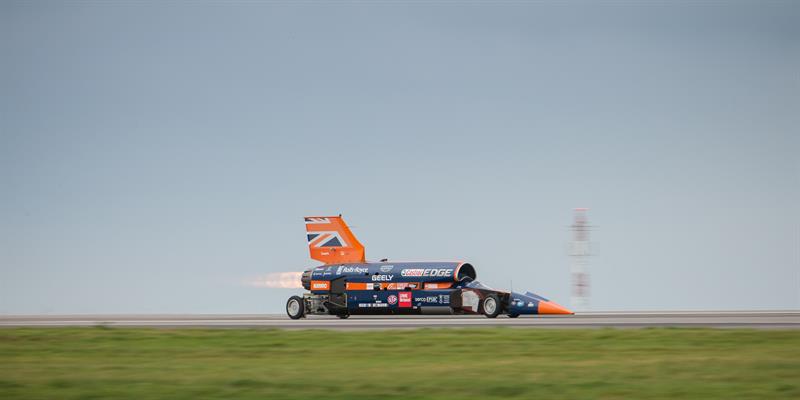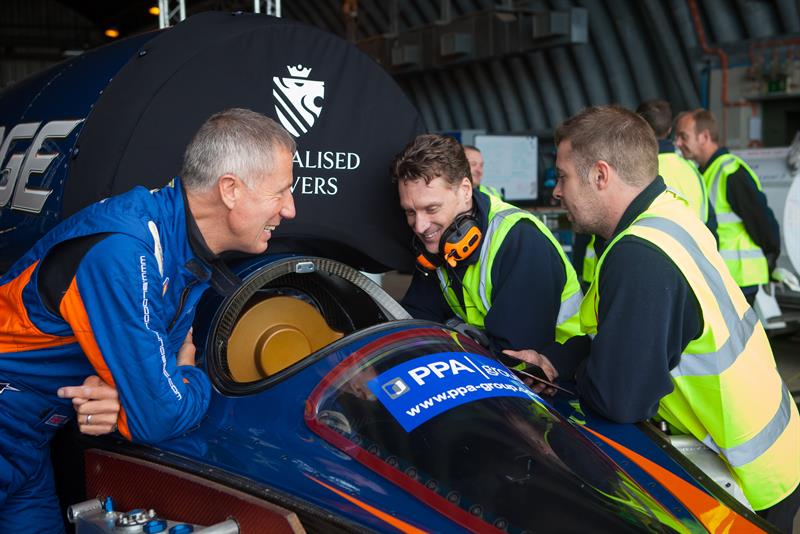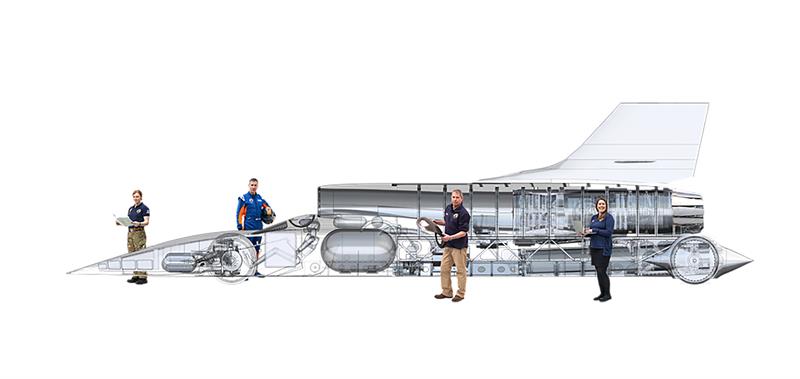If there was trepidation, however, it didn’t show on the faces of the project’s team and, sure enough, the clouds burned off with an hour to spare leaving a dry runway for the car to sprint down. As the weather improved the crowds grew and so did the excitement among the hundreds of people in attendance.
In a way, the relatively relaxed FIA regulations on how a Land Speed Record race car can be built has meant delays leading up to this event were inevitable as they give designers and engineers an infinite plethora of parameters and configurations to play with.
“The smallest engine in the car is the one that pumps the fuel to the rocket,” explains Mark Chapman, engineering director of Bloodhound SSC. “When we first looked at this back in 2008, we were bouncing around three or four different ideas. One of those was a small gas turbine, the sort of engine you’d find in a helicopter, about 1000hp. That’s the order of magnitude we needed.”
His team also looked at an electric option, but at the time the battery technology didn’t exist to power the motor for the 20 to 30s required to pump fuel to the rocket. The car now uses a Jaguar AJ133 supercharged V8 engine, which has a reduced power requirement of just 600hp. But the plan is to keep looking for an electric alternative to mirror the current automotive trend of hybrid/electric propulsion.
Chapman continues: “When we’re looking at running the car in future tests, we’d be foolish if we didn’t look at all those options again and look at an electric alternative. It could be a motor with a battery or even a supercapacitor.”
Although the current set up delivers what he needs, Chapman says that an electric option would add flexibility when it comes to packaging and weight distribution. The current AJ133 is a traditional internal combustion engine, but an electric pump and motor would not only be smaller, it would also allow the team to move the motor controllers and batteries around the car to shift its centre of gravity.
Real running
The test runs at Newquay ‘only’ required the car to accelerate to 200mph, meaning the bespoke hybrid rocket engine being developed by Norwegian based specialists Nammo – which is still being built and tested – was not installed, so propulsion came from the single Eurojet EJ200 turbojet.
Bloodhound’s driver, Wing Commander Andy Green, the only man in history to drive a car faster than the speed of sound, says: “The problem isn’t getting to 200mph, it’s exceeding 200mph.
“We’ve done some dynamic testing at slower speeds to establish the fact that reheat (afterburner) gives us a 70mph speed increase after we throttle back, but we also need the brakes above 300°C. I’ve been working with these guys for a long time. I can tell you that if I do what they tell me,we will get exactly the numbers we expect. The engineering here is that good and that impressive.”
After just 4s the car will reach 130mph, at which point Green must throttle the engine back to idle. Over the next 2.5s the car will continue to accelerate to 200mph. Here, Green must simultaneously make sure the engine is properly powering down and begin to slowly apply the brakes. This process brings the brake temperatures up into their necessary operating window, so he can properly slow the car before he runs out of tarmac.
Run complete
Green successfully completed two runs in 21 and a half minutes on the 26th October 2017 with the car topping out at 210mph on the second run.
“We came here to show the world that Bloodhound is go — I can’t think of a better way of doing it than that run,” says Green. “Not just one run, two back-to-back runs, the longest runs we’ve done, the highest speeds we’ve done and the most energy going to the brakes.”
The only obvious hint of a problem appeared on the brakes as one of them caught fire at the end of the first run. Though, according to Mark Elvin, engineering lead of mechanical design on the programme, who also has experience working with the Williams F1 Team, this is normal.
“On carbon brakes you get a lot of dust and as you slow down and the airflow decreases, the dust heats up very quickly and you can get a small flash fire,” he says. “It’s not actually the brakes that are on fire, it’s the dust on the brakes that’s on fire. When you move again the dust blows away and the fire stops. All the stuff around the braking environment is designed to deal with those temperatures.”
The Bloodhound team will now regroup, pore through the data, check wheel bearing temperatures, brake loads, vibration, tyre pressures and perform mechanical tests on fasteners to check that nothing has broken or come loose.
The next high-speed test is due in 12 months’ time either at Hakskeen Pan in South Africa or Edwards Air Force Base in America where the target is for the car to run to 650mph. After this the team will have to wait another year to attempt a run using the jet and rocket engines together at Hakskeen Pan while going for the record of 800mph, with the possibility of reaching 1000mph.

What happens in the 8 seconds between 0-200mph? Bloodhound’s driver, Wing Commander Andy Green, is an experienced RAF fighter pilot who has flown the F-4 Phantom and Tornado F3 aircraft. He holds the current World Land Speed Record of 763.035mph, set in 1997 in Bloodhound’s predecessor Thrust SSC. So, what is it like to drive the fastest cars in history?
“To get to 200mph I’m going to bring full reheat (afterburner) in, which will come in at about 30mph at 1.5g, the next 100mph will come in just after 3s. So, what I need to do is very quickly work out at what point I need to be looking at the speedo to anticipate 130mph. I’ll then need to throttle off to idle, which will send a digital request, fly-by-wire back to the engine. That will then manage its own fuel flow back to idle. The car will continue to accelerate from 130 to 200mph in 2.5s after I select idle. “During these 2.5s, I first need to make sure the idle request has gone so the engine does start to wind down. Second, I start to lean on the brake pedal because the carbon-carbon disc brakes are stone cold and they need to be hot. So, I’m putting about 40bar of brake pressure on, making sure they’re above 300°C so that when we hit 200mph the brakes start to bite and the car will then start to slow down. “A mile and a half runway looks really long until you’re doing 1000 feet every 3s... then it looks really short.” |
At a glance: Bloodhound SSC Car dimensions Length || 13.47 metres Max height || 3 metres Wheel diameter || 0.915 metres Turning radius || 120 metres Mass (Fully fuelled )|| 7786 kg Speed Design speed || 1050 mph (Mach 1.4) 0-1000mph || 55 seconds (using latest calculations) Wheel rpm || 10,000 Length of track || 12 miles Current record || 763.035 mph Power EJ200 jet engine || 90,000 N (20,233 lbf) Hybrid rocket engine || 122,000 N (27,427 lbf) Auxiliary power unit || 800 hp Brakes Air brake deployed at || 800 mph Parachutes deployed at || 600 mph Friction brakes deployed at || 200 mph
|


 “The trick is to have a very clear picture of everything you want to happen, the order you want it to happen in and know where you need to look at the right time,” he says. “It is not possible for me to be juggling the power with the throttle and the brakes and be looking at brake pressures, the speedo and the engine rpm all at the same time. It all happens in a few seconds and I’ve got a whole lot of checks to do.
“The trick is to have a very clear picture of everything you want to happen, the order you want it to happen in and know where you need to look at the right time,” he says. “It is not possible for me to be juggling the power with the throttle and the brakes and be looking at brake pressures, the speedo and the engine rpm all at the same time. It all happens in a few seconds and I’ve got a whole lot of checks to do.



